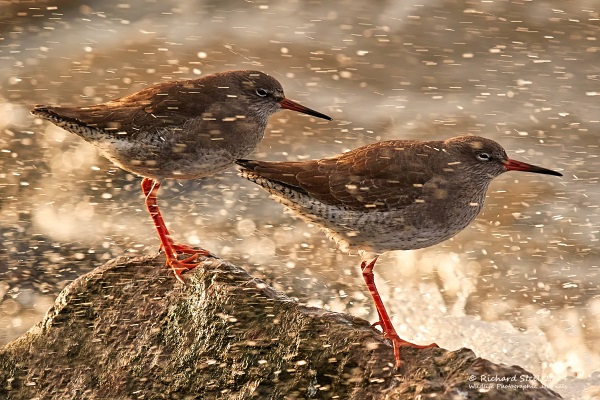Site menu:

January 2015 Newsletter
Colour Ring Report Special
- Gulls Part 1.
Red Rocks Update.
December Bird News.
Forthcoming Events.
Latest Newsletter.
Colour Ring Report Special - Gulls
Part 1 - Black-headed and Common Gulls

Like many birdwatchers I never used to look at gulls with any great
interest, that is until I started writing the gull section for the
Cheshire and Wirral Bird Report. Now I get remarks like - "who is the
saddo who counted all those gulls which are on your website?" - and I
have to admit, shamefully, it was me. But recently our little Dee
Estuary 'colour ring group' have come to realise that a fair number of
these gulls are colour-ringed so I am now motivated to do something
even more 'sad' which is to scan through the gull flocks looking at all
their legs for rings, but it is revealing some fascinating movements
for these under appreciated and misunderstood birds. We saw 18
different colour-ringed gulls in 2014, a good total in comparison to
just seven in 2013 and three in 2012. So much data has been collected
that I am writing two articles, one for small gulls* this month, and
next month the larger gulls.
* this article doesn't include Mediterranean Gulls as I wrote about these in the July 2012 Newsletter.
Black-headed Gulls
Substantial numbers of Black-headed Gulls nest in Cheshire and Wirral and the total of 2,000+ pairs is the third highest for inland breeders for any county in England. It is likely it is these birds we see on the estuary post-breeding when we get a rapid build up of birds through the summer months. As well as inland in Cheshire they nest around the estuary itself and max numbers for the past 10 years are 650 pairs at Inner Marsh Farm (now part of Burton Mere Wetlands) and 300 pairs on Parkgate Marsh, although both sites have recently suffered from predation with Lesser Black-backed Gulls at the former site and foxes at the latter site seemingly being the main culprits; in 2014 the Parkgate colony appeared to have been abandoned.
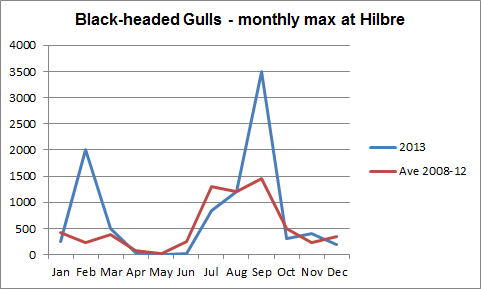
The Hilbre average for 2008-12 shows a
typical year's distribution with much lower numbers present outside the
summer peak. But, as the 2013 distribution shows, we can get larger
numbers moving in at any time and many of these birds will be
immigrants from the continent. The peak in February 2013 was part of a
much
larger number along north Wirral, probably 30,000 gulls in total
including 8,000 Black-headed on Hoylake shore on Feb 9th. Big numbers
are seen at roost sites in Cheshire with 8,000 on Rostherne Mere being
typical, but two counts of c20,000 on the north shore of
Mersey Estuary during the winter of 2011/12 were
exceptional.
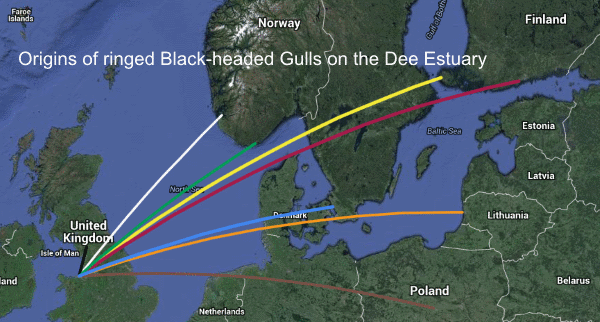
The map shows the origins of ringed
Black-headed
Gulls found on the Dee Estuary and North Wirral since 2010, five were
colour ringed and three had a metal ring one of which was found dead
and two where the details were read from photographs. It very much
reflects the map in the BTO Migration Atlas which shows the majority of
ringed birds found in north-west England coming from Scandinavia and
the Baltic whilst Black-headed Gulls ringed in the 'Benelux' countries
and France tend to end up in the southern half of the UK.
Details of the birds as follows:
1. Black line - Blue ring with white code 2C93.
Ringed as a chick on Killington Reservoir, Cumbria, on June 11th 2012.
Recorded on East Hoyle Bank on Sept 17th 2014.
2. White line - White ring with black code J1CR.
Ringed as an adult in Stavanger, Norway, on July 10th 2012.
Recorded at West Kirby in the winters of 2012/13 and 2013/14 and back
in Stavanger in the breeding season in 2013 and 2014.
3. Green line - White ring with black code J40K.
Ringed as an adult in Kristiansand, Norway, on March 11th 2004.
Recorded at New Brighton in 2005, 2006, 2013 and 2014 and at West Kirby
in 2005.
4. Yellow line - metal ring ST197057.
Ringed as a chick at Uusikaupunki, Finland, on June 26th 2000.
Found dead at Hoylake on Dec 22nd 2012.
5. Red line - metal ring ST223406.
Ringed as an adult near Helsinki, Finland, on April 16th 2005.
Recorded at New Brighton on July 11th 2010.
6. Blue line - metal ring 6400026.
Ringed as a second year bird near Malmo, Sweden, on June 14th 2001.
Recorded at West Kirby on Sept 30th 2013.
7. Orange line - white ring with black code P475.
Ringed as adult at Klaipeda-Siaure, Lithuania, on April 28th 2010.
Recorded
in Lithuania in 2011 and 2012, at Knott End-on-sea, Lancs, and
Seaforth, Lancs, in 2011, and at New Brighton in 2012 and 2013.
8. Brown line - white ring with code TMEN.
Ringed as adult at Lodz, Poland, on April 12th 2013.
Recorded at West Kirby on many dates from Sept 9th 2013 and Jan 18th
2014, and from July 7th 2014 to the end of 2014.
Common Gulls
Common Gulls don't breed in our area, and despite being called 'Common' they are a lot less numerous than Black-headed Gulls although they occupy similar habitats being seen with other gulls paddling for worms in fields and roosting on sand banks. They are normally recorded in 'tens' rather than hundreds or thousands but 2013 seem to have been a good year for them and there were 3,500 on Hoylake Shore in February with 2,500 there in March. Good numbers can be found inland and there were 2,500 on the Dee flood meadows up river from Chester on Feb 7th 2013.
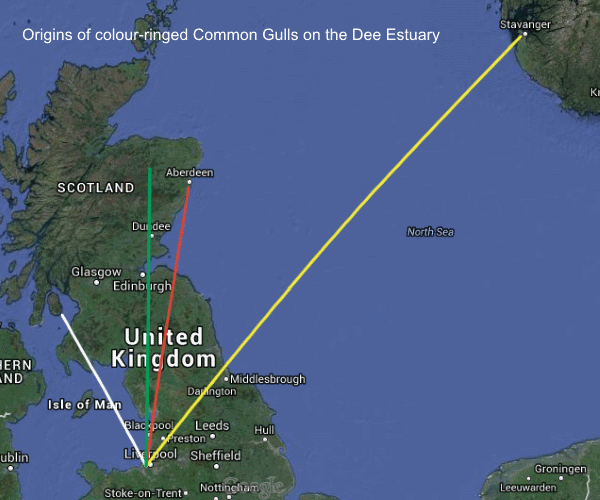
Although decreasing due to ground predation breeding Common Gulls are fairly widespread in the north and west of Scotland and three of our four colour-ringed birds have come from there. Four is a very small sample, of course, but it is interesting that it does reflect the maps in the BTO Migration Atlas which show many Scottish breeding birds heading south and south-west to the west coast of England whilst the many continental immigrants are found mainly on the east coast.
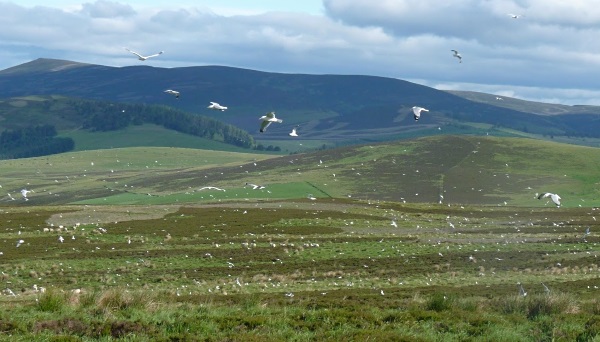
see Grampian Ringing Group Blog
Details of the birds as follows:
1. White line - Yellow ring with black
code 2E23.
Ringed as as an adult at Monamore, Isle of Arran, on July 16th 2014.
Recorded at Hoylake on Nov 8th 2014.
This was the first report of an Arran ringed Common Gull for this
project which started in 2014.
2. Green line - Orange ring with black code 2XIC.
Ringed as a chick at Tillypronie, Aberdeenshire, on June 30th 2012.
Recorded at East Hoyle Bank on Sept 27th 2014.
3. Red line - Orange ring with black
code 2XXN.
Ringed as an adult in Aldi car park, Westhill, Aberdeen, on June 21st
2013.
Recorded in Wallasey in Aug and Sept 2014.
Ringed as chick near Stavanger, Norway,
on July 2nd 2014.
Recorded on Hoylake shore on Nov 10th 2014.
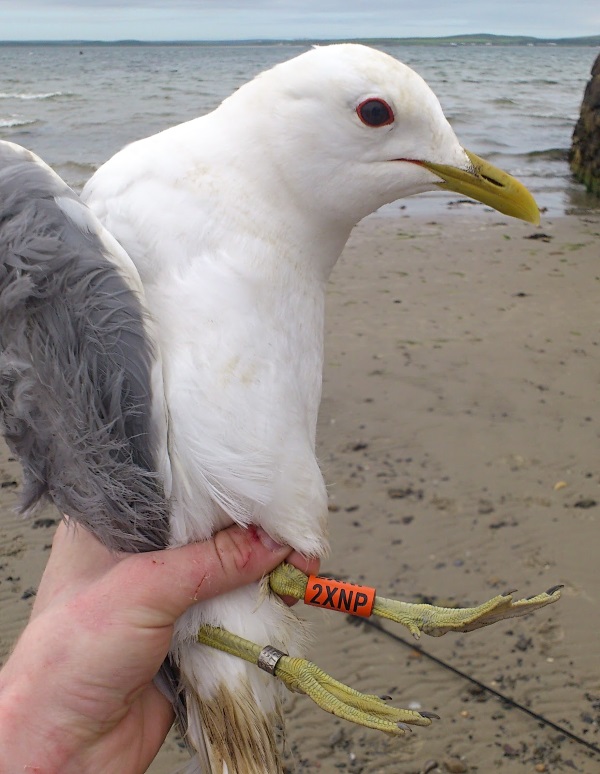
see Grampian Ringing Group Blog
Sources of Information:
1. Bird Atlas 2007-11, BTO.
2. BTO Migration Atlas, 2002.
3. D. Norman, Birds in Cheshire and Wirral (2004 to 2007 Atlas), CAWOS.4. Cheshire and Wirral Bird Reports 2008 to 2013.
5. Hilbre Bird Observatory.
6. Ray Eades, The Black-headed Gull at Pargate Parade 2010 - 2014, Bird News, CAWOS, No. 96 July 2014.
7. Those who have sent colour-ring records and photographs direct to Matt Thomas and myself including: Colin Schofield, Charles Farnell, Manu Santa-Cruz, Rob Bithell, Richard Steel, Les Hall, Steve Williams, Colin Jones, Kenny McNiffe and Alan Hitchmough.
8. The BTO (www.bto.org/volunteer-surveys/ringing/ringing-scheme).
9. The ringers and ringing groups who very kindly sent details of the birds we have seen including those from: Kane Brides in Cumbria, The Norway Colour Ringing group, the Polish Ringing Centre, the Grampian Ringing Group, the Severn Estuary Gull Group and the group from the Isle of Arran.Richard Smith and Matt Thomas
Top of Page
Red Rocks Update
At last I have some good news regarding Red Rocks.
The much delayed consultation process was completed on December 1st and you can see our detailed response to the Cheshire and Wildlife Trust's draft management plan here:
Feedback on CWT's draft management plan from the 'Red Rocks Naturalists Group'.
Thanks to all who contributed to this
document, particularly Jane
Turner who wrote most of it and whose knowledge of Red Rocks is simply
breathtaking! You will see it has an impressive list of signatories.
As a result of this and other feedback we had a meeting with CWT's Conservation Officer on December 19th, 'we' being representatives from the Red Rocks Naturalists, Dee Estuary Conservation Group, Dee Estuary Voluntary Wardens, Hilbre Bird Observatory, Wirral Wildlife and RSPB Dee Estuary. It was a constructive and positive meeting and I think we all felt that we at long last had somebody from CWT who not only listened to our concerns but fully understood what we were saying and was also very sympathetic to the points we were making.
At this stage I cannot go into further details as I don't want to prejudice the next stage of the process which will be CWT's talks with Natural England. I wish them luck!
For those who have not been following the problems at Red Rocks - see the Madness at Red Rocks article and the subsequent follow up article.
Richard SmithTop of Page
December Bird News
A good mix of weather which
included some calm
days early in the month which produced a mirror like sea, ideal for
counting birds and we had 230 Great Crested Grebes and 2,600
Common Scoter off Meols on the 4th, more unexpectedly were at least 10
Long-tailed Ducks off there two days later together with a Velvet
Scoter. Three Black-necked Grebes on Shotwick Lake at the end of the
month was an excellent record.
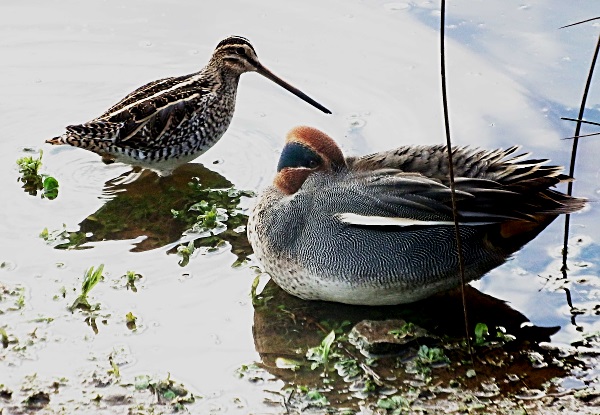
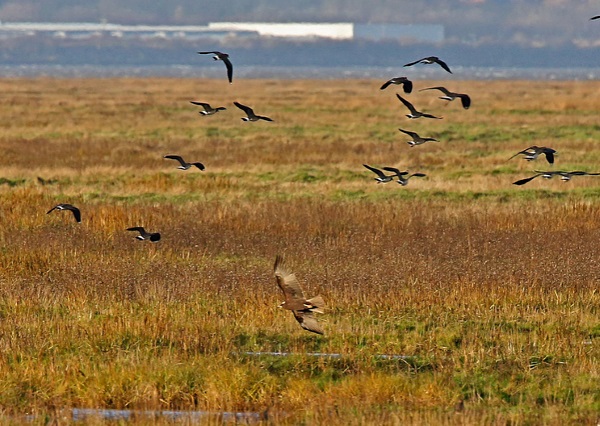
With the mild weather wader numbers were low and numbers of Purple Sandpipers at New Brighton only reached 10, with smaller numbers on Hilbre. But 10 Spotted Redshanks at Connah's Quay on the 3rd was a good count. The Black-tailed Godwits started feeding inland during the month and the highest count was 1,900 at Gilroy Nature Park, West Kirby, on the 17th.
There were 262 Brent Geese on Hilbre on the 15th which equals the highest count for this species when they were at West Kirby on December 28th 2012. There was a report of 5,000 Pink-footed Geese on Oakenholt Marsh, surely a record high for Flintshire, and up to 300 fed in a field below Dungeon Wood, Thurstaston, which is of historical importance as I'm sure they have never been recorded feeding there before.
Two Snow Bunting were at Leasowe Bay on two dates and Twites reached at least 160 at Connah's Quay although for most of the month the flock was scattered making accurate counts impossible. Single Cetti's Warblers were recorded at both Gronant and Burton Mere Wetlands.

See fromthemuddybanksofthedee blog
Richard Smith.
What to expect in January
Hopefully colder weather will mean good numbers of waders and we hope to see spectacular numbers at Point of Ayr, Hoylake and West Kirby. If we get high pressure setting in with little wind sea-watching can be very rewarding and we can get thousands of Common Scoters and hundreds of Great Crested Grebes, as well as a good number of divers and rarer grebes.

Top of Page
Forthcoming Events
January Highest Spring Tides (Liverpool)
Also
see Tides
page.
21st January, 11.28hrs (GMT), 9.9m.
22nd January, 12.14hrs (GMT), 10.1m.
23rd January, 13.00hrs (GMT), 10.1m.
24th January, 13.46hrs (GMT), 9.9m.
Forthcoming Events
Organised by the Wirral
Ranger Service , Flintshire
Countryside Service and the
RSPB (Dee Estuary):
All these events and walks have bird interest, even those not
advertised specifically for birdwatching. No need to book for these
events unless specified - please check below.
Also see 2015 Events Diary.
Birdwatching for Beginners at Thurstaston.
Did you get a bird book for Christmas? A pair of binoculars maybe? If you are interested in birds and want to learn a little about how to birdwatch then come along to Wirral Country Park for a guided walk with useful hints and tips on bird identification and fieldcraft. We will be learning “on the job” as we walk around some great birding hot spots. Bring binoculars if you have them.
Waterproofs and boots recommended. All children must be accompanied at all times.
Booking essential: 0151 648 4371
Sunday 4th January, Farmland Welly Walk at Burton Mere Wetlands.
8 am-10 am
Price: Adult £8; RSPB member £6; children half adult prices
Booking essential please ring 0151 353 8478.
Join us on this exclusive early morning, behind-the-scenes walk to get closer to the managed farmland parts of the reserve that are essential for supporting many birds through the cold winter months.
Large flocks of small farmland birds - particularly linnets and other finches - feed on our bird cover crop, which in turn attracts merlin, sparrowhawk and hen harriers to hunt. The wet grassland and barley stubble offer excellent natural grazing for the geese and swans spending the winter on the estuary.
Please note this event is weather-dependent. A cold, hard winter will push more birds to the west coast, so we'll keep our fingers crossed!
Wear wellies and warm, waterproof clothing, and bring binoculars if you have them. Price includes a hot drink and snack in the Reception Hide afterwards. Advanced booking and payment are essential.
Thursday 22nd January and Friday 23rd January, RSPB Parkgate High Tide Birdwatch.
From 10 am
Parkgate Marsh is one of the best wetland habitats in the northwest, and when it is flooded by an incoming Spring high tide, the wildlife which lives here is pushed closer, potentially delivering an awe-inspiring spectacle. Join us at Parkgate's Old Baths car park and the Donkey Stand near Nicholl's ice cream shop, where we'll be set up with marquees and telescopes hoping for the right weather conditions to really push the tide in.
You can expect great views of the large numbers of geese, ducks and wading birds which are here in their thousands for the winter. In addition, the small mammals living on the marsh can be flushed from cover, potentially attracting the kestrels, harriers and short-eared owls who spend the winter months here.
Car parking is limited on Parkgate promenade, but there is free public parking at the Old Baths car park (CH64 6RN) at the north end of The Parade, and the Wirral Country Park car park on Station Road (CH64 6QJ). There are public toilets at Mostyn Square in the middle of The Parade, and a number of pubs and cafes for refreshments.
High tide times:
Thursday 22 January; 12.14 pm (10.1m)
Friday 23 January; 1.00 pm (10.1m)
Saturday 24th January, 11.30am start
Riverbank Road Birdwatch, Heswall.
The car park at Riverbank Rd in Lower Heswall overlooks the Dee Marshes and on a very high tide is a great spot to look for waders, wildfowl and raptors flushed from the mudflats and marshes by the incoming water. Redshank, Oystercatchers, Pintail and Shelduck will be on the move and we will search for Short-eared Owls, Hen and Marsh Harriers. Waterproofs recommended as are binoculars.
No need to book, meet at Riverbank Rd, Lower Heswall.
For more information call (0151) 648 4371
Saturday 24th January, 10.30 am-2.30 pm, RSPB Point of Ayr High Tide Watch.
Price: Free (donations gratefully received on the day)
Booking essential, telephone 0151 353 8478
On a high tide in winter, the Point of Ayr saltmarsh and shingle ridge is a vital roost site for thousands of wading birds especially godwits, redshank, oystercatchers and curlews. Join us for this gentle walk from the public car park in Talacre, along the recently improved coastal path to our hide, the perfect place to watch this dramatic showcase unfold as the rising tide pushes them into closer view.
There'll also be plenty of wintering ducks brought near on the incoming tide, and there's always the chance that something unexpected will show its face! Peregrine and merlin are the two raptors most likely to take advantage of this high tide buffet, so there's a chance of seeing these hunting at close range.
Appropriate clothing and footwear, food and drink are essential.
High tide is 9.9m at 1.46 pm
Sunday 25th January, Skydancers on the Dee Estuary - Donkey Stand, Parkgate.
12noon - dusk
Price: Free
Most people have never seen a hen harrier, but once seen it is rarely forgotten. In support of the RSPB's Skydancer project, we are pleased to bring you a series of events to showcase these enigmatic birds of prey which use the marshes of the Dee Estuary as their home for the winter months.
The name "Skydancer" comes from the aerobatic displays that the male birds perform in their courtship ritual on the moors in the spring. Sadly, this has become an increasingly rare sight and they are close to becoming extinct as a breeding species in England.
This could be the last chance to see Skydancers on the Dee, so come along to Parkgate to find out more about the hen harrier story and what you can do to help save them before it's too late! Look for the RSPB marquee along the main promenade at Parkgate, where friendly staff and volunteers will be on hand with telescopes and binoculars to show you these beautiful, agile birds hunting over the marsh, and coming in to roost there at dusk. Plenty of family activities and other RSPB information will be available.
For more information on the RSPB's Skydancer project, visit
http://www.rspb.org.uk/skydancer/
Directions: The "Donkey Stand" opposite Nicholls Ice-cream shop on The Parade (B5135), Parkgate, Cheshire.
Saturday 31st January, 9 – 11.30am
Thurstaston Circle - World Wetlands Day Special
To celebrate World Wetlands Day (Feb 2nd) join the Ranger for a guided walk along one of the best wetland sites in Europe! We will walk the Wirral Way to Heswall Fields returning along the shore from Heswall to Thurstaston to look at the thousands of birds that spend the winter on the Dee Estuary. Black-tailed Godwit, Knot and Pintail should be feeding in the mud and there is the chance of a Peregrine too.
No need to book, meet at the Visitor Centre at Thurstaston. CH61 0HN
Warm waterproofs and boots are a must as paths can get muddy in winter. Bring some binoculars if you have them.
Call (0151) 648 4371 for more information.
Wednesday 4th February 10am – 3.30pm
Wildlife Photography Workshop
If you are interested in getting the best out of your DSLR camera when taking wildlife pictures the book a place on our workshop. We will have expert tuition on taking and editing pictures and photo shoots at feeding stations and drinking pools. By the end of the day you will have loads of information, hints and tips and some great pictures to take home.
This course is designed for DSLR cameras. Booking essential. £40 for the full day, places limited. Call (0151) 648 4371 to reserve a spot.
Saturday 7th February 11:30am start.
High tide Birdwatch at Hoylake:
Join the Coastal Rangers, Dee Estuary Voluntary Wardens and the RSPB on this high tide birdwatch at Hoylake to see large numbers of waders as they gather and roost on the shore. High tide is 9.1 metres at 1:03pm. No need to book. Dress warmly and bring binoculars if you have them. Meet at the bottom of Trinity Road, King’s Parade, Hoylake. For further information please telephone Wirral Country Park on (0151) 648 4371.

